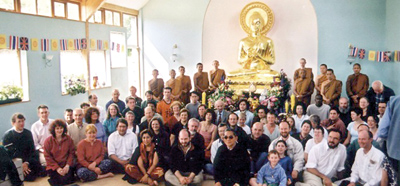Samatha – Reintroducing a Lankan meditation tradition
Samatha means calm. This Pali term is related to Samadhi, or concentration. Technically, there are several related aspects such as unification, absorption and one-pointedness though it needs to be right concentration or Samma Samadhi, balanced with Mindfulness (Sati) among other factors such as Vigour (Viriya), Joy (Piti) and Happiness (Sukha).
In the description of Samma Samadhi, it is the development of various levels of meditation or Jhana leading to wisdom (Panna). Hence the Dhammapada states that from Jhana springs wisdom but without Jhana, wisdom wanes. Indeed, it is stated that the Buddha entered final Nibbana from the highest rupa Jhana.

Samatha meditators with monks at the inauguration of a new Buddha image donated to the Centre in Wales from Thailand around 2001. Nai Boonman is in front in dark glasses
Samatha has wider connotations and represents a fundamental form of meditation along with Vipassana or insight, the culmination of concentration. Whereas the Buddhist suttas repeat the importance of Samatha, most recently, particularly since the 1950s attention has focussed on Vipassana. Strictly, Buddhist meditation is a combination of Samatha-Vipassana; terminology reflects degrees of emphasis. Arguably there is far more Samatha in the Canon and Vipassana represents the icing on the cake.
The Pali canon has little to say about the specific techniques of meditation though there are myriad pointers. This role is taken up by the commentaries and meditation teachers. The Buddha organised and set up groups of meditation teachers, mainly monks but also some lay people such as Citta the householder. Generally, lay lineages depended on monks. It was the duty of monks to uphold various traditions of meditation as did the lineage of teachers from the Buddha to Arahat Mahinda who introduced Buddhism to Sri Lanka.
The best-known meditation manuals in the Pali Canon are the Vimuttimagga (path of liberation) and the Visuddhimagga (path of purification), the latter wholly composed in Sri Lanka by Ven. Buddhaghosa. The Visuddhimagga describes in detail a system of meditation practised in Sri Lanka that eventually went to Thailand, perhaps via Burma. This tradition probably pre-dates the arrival of Buddhism to Sri Lanka, but it was cultured, developed and commented upon here, the eminent writings of which were later celebrated in Burma and passed on to Thailand.
From a lineage of monks, probably from Ayutthaya, Thailand emerged Nai Boonman, a Thai monk in India. He was aware of the destruction of the Samatha tradition of meditation he had learned due to an upsurge of a tradition of Vipassana that emerged in Burma in the 1950s. This Vipassana tradition was largely popularised by Ven. Mahasi Sayadaw who emphasised momentary rather than sustained concentration. The older Samatha traditions were eclipsed by this movement and to a certain extent lost.
By this time, a great deal of meditation tradition had disappeared in Sri Lanka due to 500 years of colonialism among other, disruptive forces. The older Samatha tradition was associated with magic and psychic powers, sometimes cultivated secretly by groups of monks who needed initiation into the techniques. A great deal of such meditation tradition is no more, given the absence of teachers along with the destruction of books, manuscripts and knowledge of their meanings.
Nai Boonman disrobed and as a layman, came to the UK by motorbike around 1963. He was experienced in meditation, but had no great intention to teach it. His meditation knowledge was, however, sought by many including students from the University of Cambridge. Nai taught meditation to those students for about 10 years before returning to Thailand promising to return if a Samatha Centre was established in the UK. These students taught others, among them, the now popular Ajahn Brahm. They set up the Samatha Trust in the UK, a lay movement that teaches meditation and provides courses on a strictly non-commercial basis. Around 1996 the Samatha Centre was formally opened in the UK and Nai Boonman came periodically to conduct courses.
In 2010, the first Samatha retreat was held in Sri Lanka by Lance Cousins, a founder of the Samatha Trust. Although in a small way, this tradition of meditation has now trickled back, having been largely lost or only practised on a limited scale. This Samatha tradition was devised as a lay tradition rather like the Goenka Vipassana tradition now popular in Sri Lanka that was also initiated by a layman.
The basic Samatha technique is described in the Visuddhimagga, which indicates it was well known in Sri Lanka in ancient times, and now, perhaps ironically it is in part being introduced to the island from England, a country that once threatened to destroy Sri Lankan culture, before it returned much of it back through archaeology, Pali scholarship and last but not least, the return of a long lost meditation tradition.



